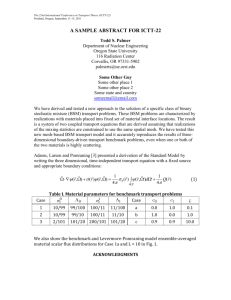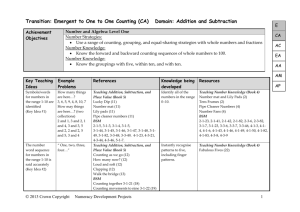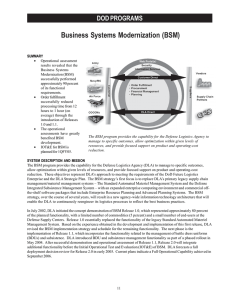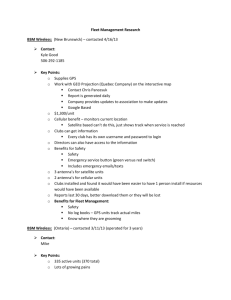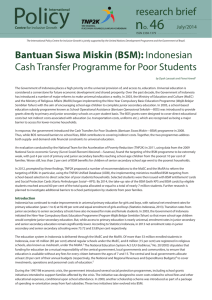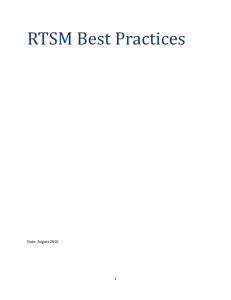BSM Transmission Interval Requirements
advertisement
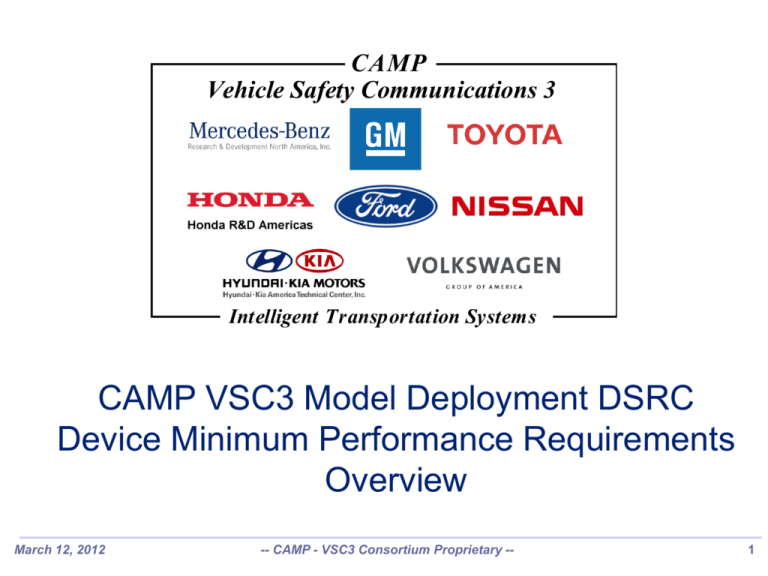
CAMP Vehicle Safety Communications 3 Intelligent Transportation Systems CAMP VSC3 Model Deployment DSRC Device Minimum Performance Requirements Overview March 12, 2012 -- CAMP - VSC3 Consortium Proprietary -- 1 Model Deployment (MD) BSM Minimum Performance Requirements (MPR) Scope • Providing minimum performance requirements to V2V safety applications based on VSC-A implementation • Requirements are based on testing and simulation analysis • The requirements are subject to change • Will be refined with post-Model Deployment data analysis • Reference 3 different device categories: • OEM integrated vehicles (IV) • Vehicle Awareness Device (VAD) • Aftermarket Safety Device (ASD) March 12, 2012 -- CAMP - VSC3 Consortium Proprietary -- 2 Table 4 Minimum Set of Data Elements with Meaningful Value to Be Included in a BSM for Vehicle Safety Application Use MD MPR 1 • Dedicated Channel Usage: Channel (CH) 172 for BSM mainly • • All three device categories that conform to the requirements shall use CH 172 for BSM transmission Under consideration: may allow Signal Phase and Timing (SPaT) and intersection map messages (GID) to be sent on CH 172 instead of being sent on other channels • Congestion Mitigation • • Congestion mitigation is expected to be applied to all three device categories Congestion mitigation requirements are expected to be published after V2V-I project completion • Transmission Power Requirements • • Will be based on the result of scalability testing in V2V-I project Currently the default power level requirement is 18 dBm March 12, 2012 -- CAMP - VSC3 Consortium Proprietary -- 3 Table 4 Minimum Set of Data Elements with Meaningful Value to Be Included in a BSM for Vehicle Safety Application Use MD MPR 2 •Security and Privacy Requirements: The Security and Privacy requirements for the integrated vehicles, VAD and ASD are being defined in conjunction with the V2V-I project •GPS configuration Requirements - WAAS/SBAS configuration Each GPS receiver in the Model Deployment program shall be configured to use WAAS corrections. •Data Frame/Element Accuracy and Latency Definition • The accuracy shall be measured at the sensor output point • The latency of a data element/frame is defined as the maximum age of the data in the outgoing BSM, from the time the data is obtained from the sensor source March 12, 2012 -- CAMP - VSC3 Consortium Proprietary -- 4 Table 4 Minimum Set of Data Elements with Meaningful Value to Be Included in a BSM for Vehicle Safety Application Use MD MPR 3- BSM Transmission Interval Requirements BSM Transmission Interval Requirements •The BSM consists of two parts: Part I and Part II. Part I contains some basic vehicle state information such as the message ID, vehicle ID, vehicle latitude, longitude, speed and acceleration. MD MPR Part II contains two data frames: VehicleSafetyExtension and VehicleStatus •The default BSM transmission interval is set to 100ms; The device is required to be capable of sending BSM at 50ms interval to accommodate potential pre-crash situation • Some of the Part II data are required to be transmitted at the same interval as Part I’s, such as PathHistory and PathPrediction, while other Part II data is required to be sent based on needs (e.g. EventFlag) March 12, 2012 -- CAMP - VSC3 Consortium Proprietary -- 5 Table 4 Minimum Set of Data Elements with Meaningful Value to Be Included in a BSM for Vehicle Safety Application Use MD MPR 5 - BSM Data-Element-Level Requirements Detail • • • Provide accuracy, latency and other requirements for each of the BSM data elements used in Model Deployment The requirement values are expected to be adjusted after Model Deployment data analysis Some of the examples are: • • • • TempID shall be randomized periodically and shall be re-randomized if the same ID was detected to be used by another device • The above description may be suitable for J2945 draft • To meet MD data collection & processing needs, TempID randomization may be implemented differently in MD The positional data shall be at least 1.5 m accurate, under certain environments/conditions For non-integrated vehicles, a data element such as TransmissionState, that cannot be populated by VADs, shall be transmitted using “not available” value Some data elements shall be sent when needed, such as EventFlags being sent when at least one event is active • Each event has its own requirements. E.g. Transmission of Hard Brake Event requires that the brake threshold be met • SAE J2735 Path History Type 4 is specified as the Path History being used for V2V safety in Model Deployment with maximum 23 points allowed • The maximum number of points needed may be discussed further * In J2735 there are many PathHistory types defined to accommodate various needs therefore PathHistory type needs to be specified in this document March 12, 2012 -- CAMP - VSC3 Consortium Proprietary -- 6 Influence to SAE J2945.1 BSM Communication MPR • MD MPR is based on CAMP field testing and simulation results • MD MPR will continue being adjusted and refined through MD program • The recommended MD requirements for actual deployment will be ported to SAE J2945.1 document for publishing • In addition to BSM, other messages defined in SAE J2735 are expected to have their specific SAE J2945.X performance requirements documents March 12, 2012 -- CAMP - VSC3 Consortium Proprietary -- 7
